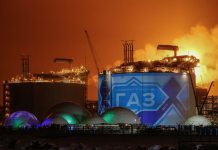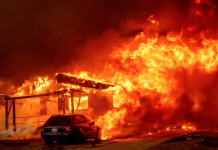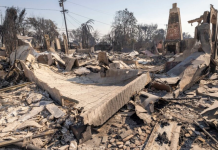It was a week of fire and ice.
It began with millions of people across the U.S. shivering amid blizzard conditions and frigid air that lasted for days, thanks to a jet stream that slips out of its usual path more often these days. Then, catastrophe in California, with wind-whipped flames taking off in a landscape parched by months of drought to become Los Angeles’ worst-ever wildfires.
To cap it off, major weather monitoring agencies confirmed 2024 as the hottest year in global history. Even more dire, four of the six agencies said it was the first full year Earth went beyond a warming threshold seen as critical to limiting the worst effects of climate change.
Welcome to one wild week of the climate crisis, scientists say. There will be more.
“For the average person, this means the changes you’re experiencing — more extreme weather, rising costs due to climate impacts, threats to food and water security — aren’t anomalies,” said Victor Gensini, a meteorology professor at Northern Illinois University. “They’re the new normal unless we take action.”
“The last week of weird weather has been alarming,” said Natalie Mahowald, chair of Earth and Atmospheric Sciences at Cornell University. “I hope it’s not a sign of things to come, because we’ve barely seen any climate change compared to what we are going to get unless we radically cut CO2 emissions.”
Here’s how the week unfolded.
Monday
The cold came first.
The Arctic is warming four times faster than the rest of the world, which means the difference between temperatures up north and down south are shrinking — along with sea ice that releases more heat into atmosphere. That means more energy bouncing off and warping or moving the polar vortex, scientists say. And climate change is also messing with the jet stream, the air currents that circle the globe.
The result? More frequent blasts of intense cold in winter even as global temperatures heat up overall.
The blizzard dumped more snow in some parts of Kansas than they usually get in a year, one Kansas State University meteorologist said. Ice-coated trees downed power lines in eastern Kentucky, and a U.S. Olympian skied on the National Mall in Washington.
Farmers rushed to move cows to keep them from freezing to death and to feed and water them as rural roads became impassable. Travel stalled as multiple states warned motorists not to chance the treacherous snow and ice.
About 200 people, many homeless, sheltered at a roller rink in Cincinnati. The alternative was frostbite or worse in exposure to temperatures that were expected to slip from freezing to sub-freezing overnight.
Tuesday
Out West, wildfire took hold.
The Palisades Fire erupted in the Santa Monica mountains and moved quickly on Santa Ana winds gusting to 100 mph — much faster than normal. The winds were so strong they grounded airplanes normally used to drop water on the flames.
The blaze reached near the Getty Museum and by the end of the day, several celebrities, including Billy Crystal, Mandy Moore and Jhené Aiko, had lost homes. Less than 72 hours before, many stars had convened to walk the Golden Globes’ red carpet.
The Eaton Fire tore through Altadena, killing 2 people and closing about 10 school districts.
Climate change laid the groundwork for California’s megafires. Atmospheric rivers dumped huge amounts of water on the region that caused plenty of plant growth. Then, a fast onset of drought dried them out, providing plenty of fodder for the flames.
Wednesday
The water system used to fight the Palisades fire in Los Angeles buckled in the morning, as some hydrants ran dry as they were overstressed without assistance from firefighting aircraft.
The Los Angeles Department of Water and Power was pumping from aqueducts and groundwater into the system, but demand was so high that it wasn’t enough to refill three 1-million gallon tanks in hilly Pacific Palisades. At least 1,000 buildings were engulfed in flames.
The Sunset Fire started, too, threatening the Hollywood Hills and forcing mandatory evacuations in Hollywood.
President-elect Donald Trump criticized state and local officials’ water management policies. But experts said critics were connecting unrelated issues and spreading false information during a crisis.
Thursday
By the afternoon, calmer winds aided firefighters in making some headway, though by that point at least five fires were still active and some burned out of control in the L.A. area.
Scenes of the destruction started to emerge. Recovery crews pulled a body from the rubble of a beachfront residence in Malibu.
AccuWeather, a private company that provides data on weather and its impact, estimated the overall wildfire damage could reach $57 billion, though much of the destruction remains to be surveyed.
At the same time, another winter storm bore down on the South, with warnings and advisories for at least 20 states. Many had gone through the same thing just days earlier.
Friday
Major weather monitoring agencies said 2024 was the hottest since record-keeping began, easily passing 2023.
Even more significant: 2024 was the first year with a global average that broke the long-term warming limit of 1.5 degrees Celsius (2.7 degrees Fahrenheit) since the late 1800s that was set as a goal by the 2015 Paris climate agreement.
Extreme weather like this week’s is “affecting so many more people all at one time,” said Barbara Hofer, a professor emerita of psychology at Middlebury College. “Increasingly, the scale is changing. The loss is mounting.”
Hofer said the growing impact may make some people deny climate change, ignore it or become numb to it as “a way to avoid what’s psychologically uncomfortable.”
Such a week can also energize positive change, she said. But Hofer said she thinks that will be harder, at least in the U.S., as Trump takes office. He’s promised to halt federal climate action and repeal existing legislation aimed at the problem.
“I worry about the denial, the misinformation, and the forces that are feeding that denial,” she said. “That’s what we have to address.”
___
Follow Melina Walling on X @MelinaWalling and Bluesky @melinawalling.bsky.social.
___
The Associated Press’ climate and environmental coverage receives financial support from multiple private foundations. AP is solely responsible for all content. Find AP’s standards for working with philanthropies, a list of supporters and funded coverage areas at AP.org.






















